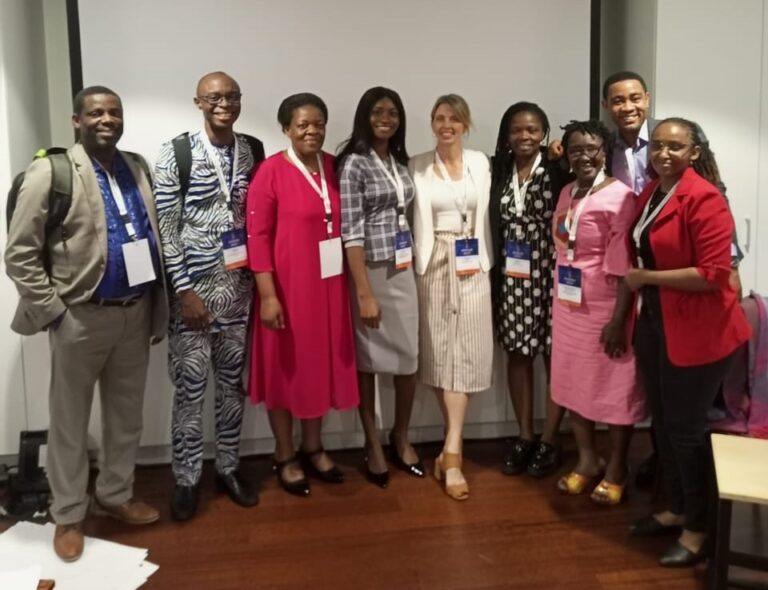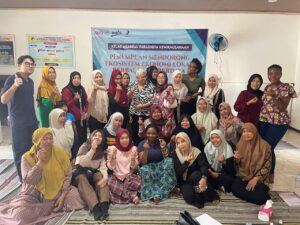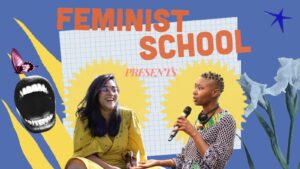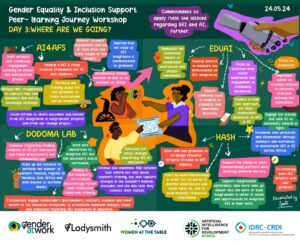In this third blog in the “Keeping the light on: Reflections on GEI and AI in Africa” series, Thummim Iyoha-Osagie, a Lawyer, PhD Student, and Research Program Manager at the Hub for Artificial Intelligence in Education (Edu AI Hub) reflects on finding meaning and relevance in her hub’s ‘Change experiment’ to co-create with sub-grantees ways to bring user and design communities closer together for AI for education.
The writing from this blog emerged from a “writeshop” organized by Gender at Work and Ladysmith as part of the “Artificial Intelligence for Development Africa,” also known as AI4D, financed by the International Development Research Centre (IDRC) and the Swedish International Development Cooperation Agency (SIDA). This was part of the final on-line Peer Learning Journeys (PLJ) workshop, modeled on Gender Action Learning (GAL), held in May, 2024.
My ‘aha’ moment
When I began working on the project at Edu AI Hub, I had not yet begun to think about gender equality and inclusion.
As the team was composed mostly of computer scientists (with some experts in law and education), I thought our work would be strictly technical and deal with other aspects of product development such as privacy, usability and ethical considerations.
However, the narrative changed for me at our pre-proposal workshop held around August 2022, when a facilitator from Gender at Work came on board during one of the sessions to share insights about the importance of gender and inclusion in Artificial Intelligence. During that workshop, she explained that historical biases in data have been shown to exclude women and marginalised communities. This has led to underrepresentation and unequal access to opportunities for the marginalised, and therefore demonstrates the need for an intentional approach to integrating GEI.
This was my ‘aha’ moment!
My eyes were opened to see that beyond strictly technical accuracies and having good management techniques for the sub grantees, it was equally important to integrate gender, inclusion and equality considerations into the project and potentially, the sub grantees’ work.


Unclear expectations, connecting the dots and the turning point
My journey was not always smooth. When I had to participate in creating a roadmap for the hub on how to integrate GEI into the project, the expectations were quite unclear. I wondered what techniques, skills or approaches would ensure that I applied a “gender lens” to the project. I cracked my head around these questions, and at one point, to be honest, I felt like I wasn’t making any headway. This was not my area of expertise, and so, it gave me reasons to be anxious.
The turning point, however, came for me gradually as the team and I started having mentorship sessions with Khanysa Mabyeka, our Gender at Work facilitator. At this point, things became clearer to me. I started connecting the dots and began to see that GEI is not just all about women and female advocacy (as I initially thought), but it is a comprehensive framework where all persons are included and made to thrive equally in an ecosystem.
I also learnt that the idea of “Gender Equity and Inclusion” goes beyond the usual binary description of male and female. As the concept of intersectionality became clear to me, I understood the importance of recognizing and including any excluded or disadvantaged members of the projects or community the hub was working with.
Starting the change journey
Eventually, as I attended the first PLJ sessions, I (along with the team) was tasked to draw up a schedule for the hub’s ‘Change experiment’. I drew up a concept note and schedule focused on working with our sub grantees titled: “Bridging the gap between user and design communities in the design of AI in education solutions”.
Our hub started the change journey with a GEI needs assessment meeting with our sub grantees. As they gave presentations about their GEI needs, I felt a light shine on me. Working together with our sub grantees to co-create solutions to the GEI needs identified, with the goal of increasing community gender inclusion awareness and integrating inclusive AI designs in education, was a particularly insightful process for me.
In addition, our hub was called upon to make presentations and participate in co-creation at the GEI session of the AfricAI Conference, Kigali 2023. These sessions were impactful for me as I learnt greatly from the experiences of other hubs who shared what their projects were doing to integrate gender. Some hubs shared how they used grassroots channels, such as girl coding clubs initiatives, in their efforts to address girls’ exclusion from STEM courses. Some challenges to GEI integration were also shared, such as a poor attitude towards gender inclusiveness in the workplace, and harmful cultural practices. I learnt these norms can be addressed through gender policy advocacy, a participatory approach of the user communities and re-orientation through awareness programs.

Next steps
As we wrap up the change experiment, I am certain that our next steps will be even more enlightening.
Our plans consist of a virtual town hall meeting where our sub grantees will invite users of their artificial intelligence solutions to further discuss the way forward in GEI integration. Also, as a way to take forward the GEI in future AI4D research learnings, I will be working together with my hub and our sub grantees to create a GEI framework for development of AI tools in education. By filling a gap in the existing GEI integration narrative, which is the absence of a framework, this new framework will be a landmark innovation, and will serve as a guideline or resource for ongoing and future projects.
I am glad for the learning journey so far and look forward with anticipation for what lies ahead.
Thummim Iyoha-Osagie is a Lawyer, PhD Student at the Faculty of Law, University of Lagos, Nigeria and Research Program Manager at the Hub for Artificial Intelligence in Education (Edu AI Hub) under the AI4D/IDRC program. Her research spans Law and Information Technologies, Data Privacy, and Online/Social Media and Artificial Intelligence Regulation. You can find her on LinkedIn and her research publications on ResearchGate.
This work is openly licensed via CC BY 4.0.
Watch this space for more reflections in the “Keeping the light on: Reflections on GEI and AI in Africa” series. The fourth blog is by Gloriana Monko, an AI practitioner, PhD researcher and Liaison Manager/Gender Coordinator of Africa’s Anglophone Multidisciplinary Research Lab, a part of AI4D. Her blog, My journey integrating gender equality and social inclusion in the AI4D Research, is about her reflections on taking on a transformative approach to shift traditional STEM education methods to be more equitable and inclusive, regardless of gender. We hope you enjoy this series and welcome your thoughts and feedback.



